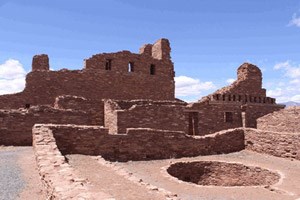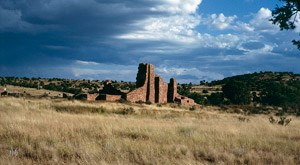
Mission San Gregorio de Abó
Salinas Pueblo Missions National Monument
Mountain Air, New Mexico
Coordinates: 34.520412, -106.241881
#TravelSpanishMissions
Discover Our Shared Heritage
Spanish Colonial Missions of the Southwest Travel Itinerary

NPS photo.

NPS photo.

Photo by Francis Gott. Courtesy of the National Park Service

Photo by HJPD. Courtesy of Wikimedia Commons.
Plan Your Visit
Abó is a National Historic Landmark and part of the Salinas Pueblo Missions National Monument, a unit of the National Park System, located 10 miles west of Mountainair off Route 60 in Torrance County, NM. The main visitor center for Salinas Pueblo Missions National Monument is located on the corner of Ripley and Broadway Sts. in Mountainair, and the Abó ruins are 9 miles west of the visitor center on US 60 and one-half mile north on NM 513. Click here for the Abó Pueblo and Mission National Historic Landmark file: text and photos. All four sites are partially wheelchair accessible. The sites are open daily with summer hours (Memorial Day - Labor Day) 9:00 a.m. - 6:00 p.m., and winter hours (rest of the year) 9:00 a.m. - 5:00 p.m. but is closed for Thanksgiving, Christmas and New Year's days. Admission is free at all times. For more information, visit the National Park Service Salinas Pueblo Missions National Monument website and its Abó website or call 505-847-2585.
Many components of Salinas Pueblo Missions National Monument have been documented by the National Park Service’s Historic American Buildings Survey, including Church of San Isidro and Church of San Buenaventura, and Mission San Gregorio de Abó. Salinas Pueblo Missions National Monument is also featured in the National Park Service American Southwest Travel Itinerary, Places Reflecting America's Diverse Cultures: Explore their Stories in the National Park System Travel Itinerary and in the American Latino Heritage Travel Itinerary.
Last updated: April 15, 2016
